The Website of Carlos Whitlock Porter
Swing Dancing "Verboten"
By Eberhard G. Wardin
Translated by C. Porter
See also:
Jazz in Concentration Camps (from DEUTSCHE GESCHICHTE, issue 60, translated by C.W. Porter)
Note:
Most of the music mentioned here (and more) can be heard for free on www.youtube. Search and ye shall find.
--
Fifty years after the end of the Second World War, the fabrication of historical legends and the concealment of facts are assuming grotesque proportions, even where harmless amusements are concerned. The propaganda image of the German must be inflated to mammoth proportions to shore up the myth of German guilt; Germans generally are depicted as cultural barbarians.
One searches in vain today for any mention of the extensive variety of both light and serious entertainment available in Berlin almost until the end of the war. American films (for example, "Police Car 88"[see footnote*] were shown in cinemas all over Germany between 1935 and 1938. "The Broadway Melody of 1938", starring Judy Garland, Eleanor Powell, Robert Taylor, and comic dancer Buddy Ebsen, was the biggest film hit in Germany, running in every cinema in Germany for weeks at a time, ahead of the most popular German film, "Der Sterne Schein ist mein und Dein" ("The stars' twinkle is mine and yours").
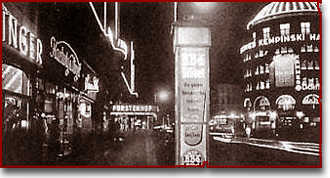
Potsdamerplatz at night. The building on the right is the "Haus Vaterland".
German dance bands played German, American and British song hits, even "swinging" German dance tunes, such as "Küß mich, bitte, bitte küß mich" (Kiss me, please, kiss me), or "Das Fräulein Gerda". Clarinetist Erhard Bauschke played "swing" at the "Moka Efti" in the Friedrichstrasse, Berlin, complete with tie and tails. The Parish-Mills jazz standard "Organ Grinder Swing" was particularly popular (the original lyrics--"Who's that coming down the street? With that good old organ grinder's beat," etc., being rendered into German as "Hofkonzert im Hinterhaus, Alle schaun zum Fenster raus", etc.).
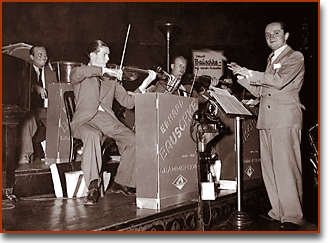
Erhard Bauschke at Moka Efti
Bauschke can be heard on line ON YOUTUBE
The tune is "Night Express to Warsaw", recorded in 1937, one of the many "train imitations" recorded in the long history of jazz.
Note the "train whistles", "polka" motifs, fiendlishly difficult mock-"Paderewski-style" piano playing (is that one pianist or two?), and very effective drumming. It may not be "jazz", but it's not German march music either.
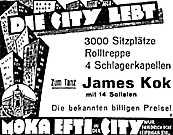
Newspaper ad for Moka Efti: "Seats 3,000, 4 pop orchestras"

The Atlantis, another night club
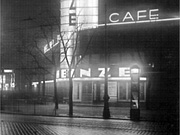
Café Heinze am Millerntor, 1937-38
Later afternoon dance tunes included not only the well-known Guy Lombardo hit "Penny Serenade" (the original lyrics--"Once I strayed 'neath the window of a lovely señorita"--being rendered into German as "Ich stand einst unterm Fenster einer Señorita"), not to mention the subsequent popularity of the "Lambeth-Walk" (a British dance tune and dance popularized in America by Arthur Murray in 1938, taken from the London play "Me and My Girl"; the dance is described as a "walking dance done in a jaunty, swaggering, strutting, knee slapping style"); nobody thought anything of it. John Abriani's Italian orchestra played "Musik für Mizzi" in the "Blumengarten Oberschöneweide", while Tullio Mobiglia's Italian orchestra was quite popular in a number of Berlin bars.
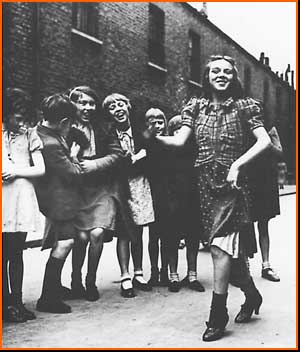
"Lambeth Walk"demonstration in London slum
Jean Omer's Belgian 15-piece orchestra with lady vocalist was still playing at the "Delphi Palast" as late as 1943; Jomny Rambell played the well-known big-band jazz standard "Moten Swing" (written by Kansas City musician Bennie Moten, whose big band was taken over by Count Basie), at the "Efti", both in Berlin. Somewhat later, at the "Delphi", also in Berlin, trumpet player Günter Herzog--enjoying a deferment from military service, even at that time--appeared with a 15-piece orchestra, described in neon lights on the roof as "a new star in the Delphi", the entire roof of the "Delphi" being designed to resemble a starry sky.
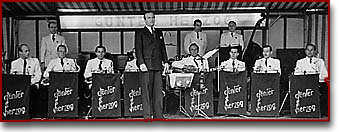
Günter Herzog and his orchestra
Kurt Widmann, an excellent trombonist, could still be heard with his orchestra in the "Red Room" of "Imperator" (a multi-story Berlin café and restaurant with dance hall) in 1943, playing a repertoire consisting entirely of "swing". At least 12 top orchestras were already playing in Berlin as early as 1936, in Berlin's most expensive hotels (such as the "Adlon", "Eden", and "Esplanade") as well as in less expensive dance halls (for example, Bernhard Etté or Walter Lemke's German-American dance orchestra, or Pat Bonen and his Orchestra, on the first floor of the "Hochhaus am Alexanderplatz", which was still standing in 1999).
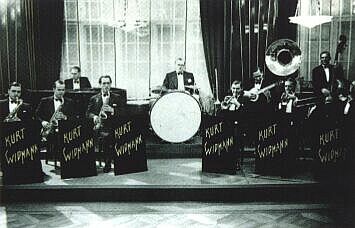
Kurt Widmann
The house orchestra at the "Delphi", conducted by band leader Heinz Wehner, repeatedly played at other hotels as well. Trumpeter Kurt Hohenberger and his Orchestra appeared at the "Quartier Latin" and the "Femina"; Barnabas von Gezy played at the "Hotel Esplanade" for many years. As late as late 1943, melodious recorded versions of "Deep Purple" and "I Promise You" were released on the "Brunswik" label, featuring Danish vocalist Fin Olsen. In Berlin, "Brunswik" recordings of English clarinettist Harry Roy, were widely sold; particularly popular song hits included "Tulip Time" (an "Andrews Sisters" hit) and "Stop Beatin' 'Round the Mulberry Bush" (a smash hit chiefly associated with the Count Basie big band), and "Boo-Hoo" (a Carmen Lombardo hit resurrected by Little Richard in the 1950s). The orchestra of the English-language radio-station in Sottens, Switzerland, played "swing" every evening, with listeners all over Germany. British pianists Ivor Moreton and Dave Kay played hits like "A Tisket, A Tasket" (an Ella Fitzgerald hit). A particularly popular new release in Germany itself was "Bei Dir war es immer so schön", recorded with only trumpet and piano. Another extremely popular tune was the sentimental Harry Warren-Al Dubin Broadway standard "September in the Rain"; recordings of "Amapola" by "Rumba King" Xavier Cugat (also a big Jimmy Dorsey hit) were available in a record store and music shop located near the Jerusalemer Kirche, Berlin. I personally bought these records while on furlough from the Russian front. One of the most popular hits was the Jimmy Dorsey hit "Sweet and Lovely," known in Germany as "Wen ich liebe".
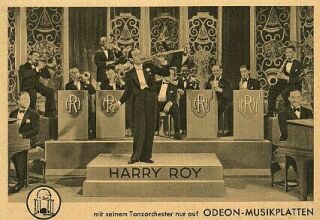
Harry Roy
Dancing was permitted in Berlin as late as 1942 and was prohibited in 1943 as a result of the danger of air raids and as a gesture of respect for German soldiers fighting on the Eastern Front; the same danger made the prohibition superfluous. Dance music continued to be played for listening, however; many of the listeners being soldiers on furlough. Over-zealous Party officials naturally objected to overly-grotesque or distorted "primitive" dance styles, especially when accompanied by gestures indicating opposition to the regime: a "political show" featuring jazz numbers in Hamburg. A jazz number known as "Two Left Feet", by Fud Candrix, was particularly disliked by over-zealous Party officials, but the music itself was not prohibited.
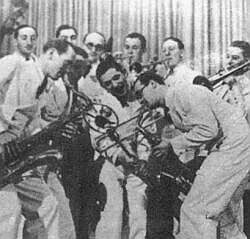
Fud Candrix (left, with saxophone)
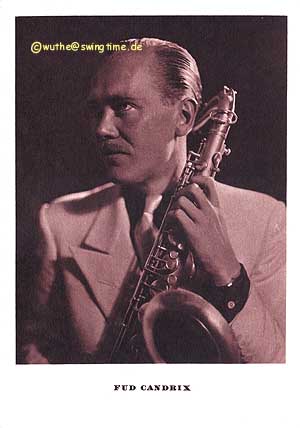
The London Philharmonic Orchestra, conducted by Sir Thomas Beecham, as well as Radio London's great dance orchestra featuring guitarist Eddy Peabody, played at the Berlin "Wintergarten" in 1938 with great success. "Swing" achieved its height of popularity in Berlin during guest appearances of orchestras conducted by Teddy Stauffer, Fud Candrix or Ernst van't Hoff (said to have played the "best swing in Europe", with "a slow drag") at the Wilmersdorf in Berlin as late as August 1944, as well as in the "Cafe Leon" on the Lehniner Platz (Berlin). Despite the horrendous losses through air raids, despite the collapse of the "Heeresgruppe Mitte" (Central Army Group), Hans Warner Kleve's 16-man orchestra still played dance music ("it was a very lively atmosphere"). Kleve said later :
"Every dance band had American tunes in its repertoire, people requested these tunes, and the bands played them. Nobody thought anything of it!"
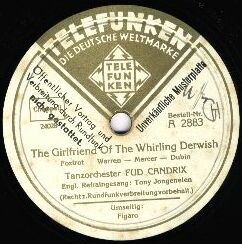
Typical Fud Candrix hit: "Girlfriend of the Whirling Dervish".
The record is marked "Not approved for public performance or radio broadcasting", yet Candrix was still playing publicly in 1942, even entaining members of the Wehrmacht, apparently without official interference.
Candrix was Belgian, from Tongeren. Many of his recordings are on youtube, for example, https://www.youtube.com/watch?v=-3ivVC9H4LE.
There was also a very active jazz scene in Belgium under the Occupation.
See also http://www.swingtime.de/cd_wuthe/dtswingdt.html
The Cafe "Leon" was used as the stage for small-scale artistic productions for the "Jüdischen Kulturbund" (Jewish Cultural Association) between 1935 and 1937, probably for an exclusively Jewish audience. Franz Thon, subsequently the leader of a "big band" on NDR [radio], Hamburg, "played 'private gigs' for an exclusively Jewish audience there in approximately 1937!"
German dance orchestras even accompanied German troops to remote areas of distant occupied territories, playing "swing" for the Russian civilian population as soon as the combat situation permitted it, for example, in the "City Theater of Brjansk". A similar event from my own experience was held in a building at the Potschinok airport, with a smaller band (featuring songs like "Wind weht weit übers Meer", and others) to entertain pilots from "Kampfgeschwaders General Wever" and Colonel Rudel's "Stukageschwader Immelmann" as well as Hungarian pilots fighting on the German side. An orchestra conducted by a non-commissioned officer named Kistenmacher also played on the "Soldatensender Minsk" (Minsk Military Radio); this was in addition to the dance orchestras of numerous other European radio stations, many of them, even in Italy, featuring a group of female vocalists called the "Grasmückentrio" ("The Three Warblers"). Lutz Templin's Orchestra--not to mention "Charlie And His Orchestra"--played excellent swing music, transmitted night after night by the "Kurzwellensender Berlin" (Berlin Short Wave Transmitter) for the soldiers of the Ostheer (Army of the East), of which I was a member. The 35-piece orchestra of a mobile military transmitter containing many former American POWs--musicians who joined voluntarily--was probably unsurpassed, even by the American-British orchestras entertaining the troops. These broadcasts, which were also transmitted to North Africa, were a great annoyance to the Allies. The mobile military transmitter was often electronically located and bombed soon after beginning its broadcasts, after which the broadcasts were interrupted and relocated; the broadcasting then resumed.
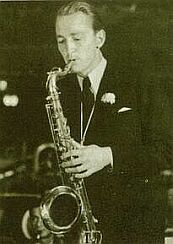
Teddy Stauffer
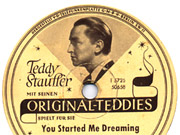
Teddy Stauffer record label, 1936
Programmes consisting of classical music, piano concerts and song evenings were, of course, also available to German soldiers all over Europe, but German attitudes towards "swing" were really quite the opposite of what people today imagine. To musicians, as well as for the most non-musical listeners, "swing" represented the art of chorus playing and improvisation, constituting the fascination of this style of music! It should be added that the legend of the guilt of the Reichsmusikkammer, represented by the slogan "Swing Dancing 'Verboten'" was nothing more than an advertising slogan for a record company!
The Big Band era, and the wild heyday of the Nat Gonella, Les Brown and Woody Herman orchestras, is long gone, and with it, the sentimental memory of quiet melodies of German orchestras on Berlin short-wave transmitters located in radio transmitter huts in the deep snows before Moscow.
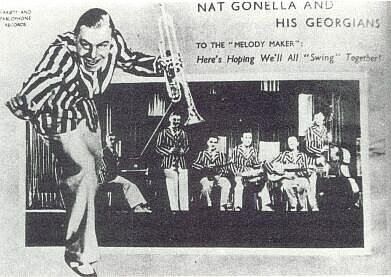
Nat Gonella
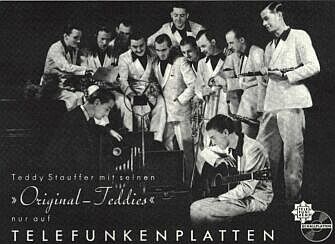
Teddy Stauffer and the "Original Teddies"
Very few people still remember listening to "So wird's nie wieder sein" or "I'm in the Mood for Love" over field transmitter headphones, played for Germany's best--our comrades in the infantry--starting after the fading of the credits of the "Belgrader Jungen Wachtpostens" on the "Soldatensender Belgrad" every night at exactly 10 P.M., and closing with "Lili Marleen" at 12 midnight, when the trumpeter for the military radio transmitter in Rome played a softly sentimental rendering of "Arrivederci", signing off until the broadcasts started crackling again in the ether of the following grey morning.
Source: Knud Wolffram, Tanzdielen und Vergnügungspaläste: Berliner Nachtleben in den dreißiger und vierziger Jahren; von der Friedrichstraße bis Berlin W, vom Moka Efti bis zum Delphi, Reihe deutsche Vergangenheit, Vol. 78: "Stätten der Geschichte Berlins", Edition Hentrich, Berlin 1992, pp. 214-216, ISBN 3-89468-0-47-4.
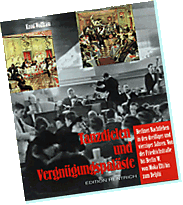
"Dance Halls and Pleasure Palaces: Berlin Night Life in the 1930s and 40s"
Click here for enlargement
Notes
First published in German in Vierteljahreshefte für freie Geschichtsforschung 4(3&4) (2000), pp. 353f. Translated by Carlos W. Porter.
[footnote*] |
Translator's note: Original title unknown; a Hollywood B-movie about cops and robbers during the Prohibition era. |
Source: The Revisionist 1(1) (2003), pp. 81-83.
Further notes by translator: the author of this article, Eberhard G. Wardin, who apparently died recently, sent me a large volume on Nazi-era jazz, many newspaper clippings, and a tape, recorded off German radio, re-broadcast in the 1990s, of Nazi-era jazz from the 1930s and 40s. One of the tunes is "Caravan", by Duke Ellington. There is also a fairly good Fats Waller imitation. It is simply untrue that the National Socialists "abolished jazz". I also have a video entitled "Hitler's Berlin", an official National Socialist propaganda film made in 1938, showing Germans dancing to American jazz on the Alexanderplatz; the tune is "Goody Goody". It is sometimes claimed that Teddy Stauffer, who was of Swiss nationality, was forced to leave Germany in 1938. That appears to be untrue. According to the link below, he left Germany upon the outbreak of the war.
According to other sources, he left Germany in 1943. The author also sent me a lengthy article from a serious German historical journal about jazz bands in German concentration camps (Deutsche Geschichte, issue 60, JAZZ IM KZ: MUSIKLEBEN IN DEUTSCHEN KONZENTRATIONSLAGERN) [Jazz in the Concentration Camp: Musical Life in German Concentration Camps], a review of Musik an der Grenze des Lebens. Musikerinnen und Musiker aus böhmischen Ländern in nationalsozialistischen Konzentrationslagern und Gefängnissen [Music on the Edge of Life: Men and Women Musicians from the Bohemian States in National Socialist Concentration Camps and Prisons]
by Milan Kuna (available in a new edition from amazon.de) (ISBN: 3861502607). I'll translate the article when I get time, with a few scans. It appears that these bands were very popular with both inmates and guards.
How a thriving jazz scene is compatible with a program of mass extermination in the same camps, I leave to others to explain. - C.P.
On the Internet, see http://www.return2style.de/swingaring/amiorche.htm
or search www.youtube by name of musician, for example, Teddy Stauffer or Erhard Bauschke.
To buy German jazz from the 30s and 40s on CDs, search google by name of musician, or search for PUMPKIN PIE RECORDS. They also sell the book pictured above, by Knud Wolffram.
(There is something wrong with the links. To buy the book, you have to enter the name "Knud Wolffram" in the search window near the bottom of the page, or click on Tanzdielen und Vergnügungspaläste at the very bottom, in the list.)
The name is spelled "Wolfram" on the book and "Wolffram" on the Internet, probably because Wolfram is a fairly common name in Germany.
Knud Wolffram (or "Wolfram") appears to own the PUMPKIN PIE record company, and is to be congratulated for rendering a great service, both musically and historically. He also sells some truly great records.
This article only scratches the surface.
The slogan SWINGTANZEN VERBOTEN was invented, not in the 1930s or 40s, but in the 1970s, apparently by Proper Records Ltd of Lancaster, England, to sell German jazz records recorded in the 1930s, marketed as "Properbox 56", now sold as a 95-track, 4-CD set, with a 60-page booklet by a Dutch jazz expert, for $24.98 from www.amazon.com (ISBN: B0000918PJ). Very clever, since "Verboten" is one of the few German words every Englishman knows.
"The Broadway Melody of 1938", mentioned in the second paragraph above, is also available on video from www.amazon.com.
For a few more "Nazi jazz" selections audible on line, just search youtube by name of musician.
Fud Candrix's name is often misspelled, and he is sometimes mistakenly listed as German, although his "orchestra" may well have been, for all I know. "Tanzorchester" is also sometimes misspelled.
The interpolated ad-lib with swing-style piano accompaniment on the number "You're Driving Me Crazy", a well-known American hit, played by "Charlie and his Orchestra", should, if nothing else, dispel for all time the notion that the "Nazis" had no sense of humour.
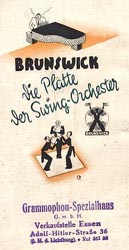
Translation: "BRUNSWICK: The Swing Orchestra Label.
Speciality Record Dealers Ltd., Essen branch, 36 Adolf Hitler Street,
[name of suburb illegible]."
- C .P.
See also "Swing Time" for Hitler by Brian X. Morton, writing in The Nation, September 15, 2003.
Quote: "One of the strangest photographs of the war was taken by Schulz-Koehn outside La Cigale, a jazz club in Paris. It shows a gypsy (Django), four Africans and a Jew posed smiling beside a fellow officer. The Germans were there not to arrest these men but to listen to them play...The same regime that first attempted to expunge the new Germany of the taint of
jazz also kept many of the country's swing musicians in employment..."
One of the reviews of the 4-CD set on www.amazon.com
reads, in part:
"The remaining two discs are a musical treasure trove, featuring music from
German-occupied countries (mostly the Netherlands, Belgium, and France). A
number of highly talented artists remained in these countries throughout the
war, and managed to get their music on record, either through the backdoor
influence of local officials who secretly loved swing, or by changing their
names (and the titles of songs) to bypass the banned lists. Here you'll find
little-known gems by Django and Joseph Reinhardt, Gus Viseur, Svend Asmussen,
Dick Willebrandt, and many other artists who were unjustly forgotten due to the
unfortunate circumstance of war."
Another reviewer states: "...The music is clean and enjoyable to listen to, including the parody songs and
stabs at Churchill. If you are a vintage music collector, this a must-have
collection."
---
MADE IN RUSSIA - THE HOLOCO$T
Return to ARTICLES PAGE
Return to CONTENTS PAGE

















